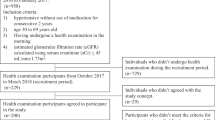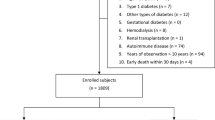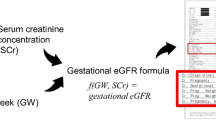Abstract
Objective:
Evaluate the value of random urinary protein-creatinine (PrCr) and calcium-creatinine (CaCr) ratios to predict 24-h proteinuria in hypertensive pregnancies.
Study Design:
Spot urine samples were collected before routine 24-h urine collections from consecutive pregnant women with hypertension (n=83). Reliability of spot urinary PrCr and CaCr to detect significant proteinuria (⩾300 mg/day) using 24-h urine protein as ‘gold-standard’ was assessed by receiver-operating characteristic (ROC) curve.
Results:
Fifty-one patients (61.4%) had significant proteinuria (45 pre-eclampsia, 5 superimposed pre-eclampsia, 1 renal hypertension). Area under ROC curve to predict proteinuria was 0.82 (95% confidence interval (CI) 0.73 to 0.92, P<0.001) for PrCr and 0.55 (95% CI 0.43 to 0.68, P=0.2) for CaCr. A cutoff value of >0.19 for PrCr best predicted significant proteinuria with sensitivity, specificity, positive and negative predictive values and likelihood ratios (positive and negative), respectively, of 80.4, 68.8, 80.4, 68.8%, 2.57 and 3.51.
Conclusion:
Spot urinary PrCr predicts total urinary protein excretion in hypertensive pregnancies.
This is a preview of subscription content, access via your institution
Access options
Subscribe to this journal
Receive 12 print issues and online access
$259.00 per year
only $21.58 per issue
Buy this article
- Purchase on Springer Link
- Instant access to full article PDF
Prices may be subject to local taxes which are calculated during checkout

Similar content being viewed by others
References
Waugh JJ, Clark TJ, Divakaran TG, Khan KS, Kilby MD . Accuracy of urinalysis dipstick techniques in predicting significant proteinuria in pregnancy. Obstet Gynecol 2004; 103: 769–777.
Adelberg AM, Miller J, Doerzbacher M, Lambers DS . Correlation of quantitative protein measurements in 8-, 12-, and 24-h urine samples for the diagnosis of preeclampsia. Am J Obstet Gynecol 2001; 185: 804–807.
Neithardt AB, Dooley SL, Borensztajn J . Prediction of 24-h protein excretion in pregnancy with a single voided urine protein-to-creatinine ratio. Am J Obstet Gynecol 2002; 186: 883–886.
ACOG technical bulletin. Hypertension in pregnancy, Number 219, January 1996 (replaces no. 91, February 1986): Committee on Technical Bulletins of the American College of Obstetricians and Gynecologists. Int J Gynaecol Obstet 1996; 53: 175–183.
Ramos JGL, Martins-Costa SH, Mathias MM, Guerin YLS, Barros EG . Urinary protein/creatinine ratio in hypertensive pregnant women. Hypertens Pregnancy 1999; 18: 209–218.
Yamasmit W, Chaithongwongwatthana S, Charoenvidhya D, Uerpairojkit B, Tolosa J . Random urinary protein-to-creatinine ratio for prediction of significant proteinuria in women with preeclampsia. J Matern Fetal Neonatal Med 2004; 16: 275–279.
Saudan PJ, Brown MA, Farrell T, Shaw L . Improved methods of assessing proteinuria in hypertensive pregnancy. Br J Obstet Gynaecol 1997; 104: 1159–1164.
Waugh JJ, Bell SC, Kilby MD, Blackwell CN, Seed P, Shennan AH et al. Optimal bedside urinalysis for the detection of proteinuria in hypertensive pregnancy: a study of diagnostic accuracy. Br J Obstet Gynaecol 2005; 112: 412–417.
Al RA, Baykal C, Karacay O, Geyik PO, Altun S, Dolen I . Random urine protein-creatinine ratio to predict proteinuria in new-onset mild hypertension in late pregnancy. Obstet Gynecol 2004; 104: 367–371.
Franceschini N, Savitz DA, Kaufman JS, Thorp JM . Maternal urine albumin excretion and pregnancy outcome. Am J Kidney Dis 2005; 45: 1010–1018.
Rodriguez-Thompson D, Libermann ES . Use of a random urinary protein-to-creatinine ratio for the diagnosis of significant proteinuria during pregnancy. Am J Obstet Gynecol 2001; 185: 808–811.
Comper WD, Osicka TM . Detection of urinary albumin. Adv Chronic Kidney Dis 2005; 12: 170–176.
Durnwald C, Mercer B . A prospective comparison of total protein/creatinine ratio versus 24-h urine protein in women suspected with preeclampsia. Am J Obstet Gynecol 2003; 189: 847–852.
Young RA, Buchanan RJ, Kinch RA . Use of protein/creatinine ratio of single voided urine specimen in the evaluation of suspected pregnancy-induced hypertension. J Fam Pract 1996; 42: 385–389.
Quadri K, Bernardini BS, Greenberg A, Laifer S, Syed A, Holley JL . Assessment of renal function during pregnancy using a random protein to creatinine ratio and Cockcroft–Gault formula. Am J kidney Dis 1994; 24: 416–420.
Robert M, Sepandj F, Liston R, Dooley K . Random protein-creatinine ratio for the quantification of proteinuria in preeclampsia. Obstet Gynecol 1997; 90: 893–895.
Price CP, Newall RG, Boyd JC . Use of protein: creatinine ratio measurements on random urine samples for prediction of significant proteinuria: A systematic review. Clinical Chemistry 2005; 51: 1577–1586.
Evans W, Lensmeyer JP, Kirby RS, Malony ME, Broekhuizen FF . Two-hour urine collection for evaluating renal function correlates with 24-h urine collection in pregnant patients. J Matern Fetal Med 2000; 9: 233–237.
Kazerooni T, Hamze-Nejadi S . Calcium to creatinine ratio in a spot sample of urine for early prediction of preeclampsia. Int J Gynecol Obstet 2003; 80: 279–283.
Baker PN, Kackett GA . The use of urinary albumin-creatinine ratios and calcium-creatinine ratios as screening tests for pregnancy induced hypertension. Obstet Gynecol 1994; 83: 745–749.
Valerio EG, Ramos JG, Martins-Costa SH, Muller AL . Variation in the urinary protein/creatinine ratio at four different periods of the day in hypertensive pregnant women. Hypertens Pregnancy 2005; 24: 213–221.
Tsujikawa H, Machii R, Hiratsuka N, Shiba K, Fukuta H, Sakamoto H et al. Evaluation of novel test strip to measure albumin and creatinine in urine. Jpn J Clin Pathol 2005; 53: 111–117.
Rizk DEE, Nasser M, Thomas L, Ezimokhai M . Women's perceptions and experiences of childbirth in United Arab Emirates. J Perinat Med 2001; 29: 298–307.
Snedecor GW, Cochran WG . Statistical Methods. 8th edn. Iowa: Iowa State University Press, 1989; 102–105.
Gaspari F, Perico N, Remuzzi G . Timed urine collections are not needed to measure urine protein excretion in clinical practice. Am J Kidney Dis 2006; 47: 1–7.
Haas DM, Sabi F, McNamara M, Rivera-Alsina M . Comparing ambulatory spot urine protein/creatinine ratios and 24-h urine protein measurements in normal pregnancies. J Matern Fetal Neonatal Med 2003; 14: 233–236.
Author information
Authors and Affiliations
Corresponding author
Rights and permissions
About this article
Cite this article
Rizk, D., Agarwal, M., Pathan, J. et al. Predicting proteinuria in hypertensive pregnancies with urinary protein-creatinine or calcium-creatinine ratio. J Perinatol 27, 272–277 (2007). https://doi.org/10.1038/sj.jp.7211689
Received:
Revised:
Accepted:
Published:
Issue Date:
DOI: https://doi.org/10.1038/sj.jp.7211689
Keywords
This article is cited by
-
Periodic urinary protein creatinine ratio for predicting significant proteinuria in preeclampsia in different alternatives: time effectiveness analysis
Archives of Gynecology and Obstetrics (2010)



